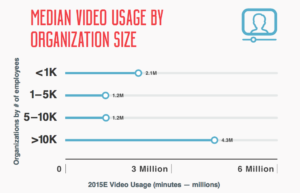
We pulled data from over 60 organizations across a wide range of industries to gather some new insight on just how much video collaboration organizations actually use. The metric of choice: annual video collaboration minutes.
Our report focuses purely on quantitative usage – things like organization size (by # of employees) and usage in various industries. Look to this report to give you an idea of the growth and scale of video collaboration from 2013 – 2015.
Turns out that we were correct not to assume that video usage and company size would be a direct correlation. Here is the visual we used in our report:
You can see that the median organization with less than 1,000 employees (we’ll call them the powerhouse organizations) are consuming 2.1 million video collaboration minutes annually. The median for organizations with 1k – 5k employees is 1.2 million and it’s the same for organizations with 5k – 10k (trailing the median for smaller organizations by nearly 1,000,000 video minutes).
Median video collaboration usage for organizations with greater than 10,000 employees is a smaller number (4.3 million annual video minutes) than expected relative to organizations with less than 1000 employees.
If size really mattered, we would likely see a direct correlation between usage and size, meaning the median annual usage for companies with less than 1,000 employees would be less than half a million video minutes (0.43M).
Video Conferencing Usage Report
Powerhouse usage in mid-sized organizations is possible because of a fundamental difference in the way these companies manage and encourage adoption of video technologies compared to enterprises. They are using nearly half as much video as organizations that are 10x larger, because of video democratization. This is a trend that reflects the communication needs of the changing workforce as a whole, but ultimately it comes down to knowledge workers within the organization.
Some industries trend towards a larger # of knowledge workers based on the nature of the business they’re in. Imagine how important video collaboration is to a consulting firm for instance, where knowledge sharing is the core service.
Take a look at our industry usage report. You’ll find data across the following industries: technology, consulting, legal, healthcare, financial and higher education. Although these industries are by no means the only industries that are in the process of video democratization, video seems to be democratizing the way in which we communicate.







